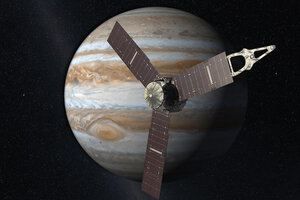NASA's Juno probe breaks solar-powered distance record
NASA's Juno probe broke a world record and became the most distant solar-powered spacecraft. The probe is on the way to Jupiter and shows how the sun can help man explore the solar system.

This 2010 artist's rendering depicts NASA's Juno spacecraft with Jupiter in the background. Juno has set the record for longer distance traveled by solar power.
AP Photo/NASA/JPL
At 493 million miles from the sun, NASA’s Juno space probe broke a world record.
The NASA probe sent to analyze and study the surface of Jupiter broke a record as the most distant solar-powered space craft in human history, according to a press release from the US space agency. The previous record-holder had been Europe's Rosetta spacecraft, launched in 2004, which traveled 492 million miles to land on a passing comet. The Juno probe still has another roughly 30 million more miles to go, which means a big lead any solar powered distance competition.
Previously, only eight spacecraft have navigated as far out into space as where Juno broke the record. All eight utilized nuclear power sources to fuel themselves.
Despite the success, it is unlikely Juno will be the start of a new trend of solar-powered exploration into the depths of space.
"Juno is all about pushing the edge of technology to help us learn about our origins," said Scott Bolton, Juno principal investigator at the Southwest Research Institute in San Antonio, in the NASA press release. "It just seems right that the sun is helping us learn about the origin of Jupiter and the other planets that orbit it."
When Juno launched in 2011, it weighed four-tons. It was equipped with three solar array, each measuring 30 feet in length, and possessing more than 18,000 individual solar cells. The rationale behind the weighty payload was logistics, according to the press release.
At Earth's distance from the sun, the equipment Juno has could have generated 14 kilowatts of electricity. In space, further away from the sun, the amount of power that can be generated from the same equipment declines dramatically. At Jupiter, sunlight will carry 25 times less power, according to NASA.
The decrease in power, means solar-powered probes aren’t appropriate for missions too far from the sun. In contrast, Voyager I and Voyager II, both powered by plutonium, were launched as long-range exploration units. Voyager I has reached interstellar space (about 12.5 billion miles away) and Voyager II is close behind in the heliosheath, the region before interstellar space, according to NASA.
Solar-powered probes also come with a variety of technical obstacles.
The European Space Agency’s Philae comet lander, which the ESA is still trying to contact, also runs on solar power. However, after an incident with its landing in 2014, the probe settled on a portion of the comet that was too shaded to power its panels. The result was a seven-month hibernation until it was able to recharge.
Juno is still awake and traveling.
"While our massive solar arrays will be generating only 500 watts when we are at Jupiter, Juno is very efficiently designed, and it will be more than enough to get the job done," said Rick Nybakken, Juno's project manager from NASA's Jet Propulsion Laboratory in the release.
Juno is scheduled to reach Jupiter on July 4, 2016. The spacecraft will stay in orbit for the next year, completing 33 rotations of the planet and skimming close to the surface, within 31,000 miles.
Scientists and researchers hope Juno's analysis of the planet will provide answers to many questions about the enigmatic giant Jupiter. Juno will gather data on planet’s geology, structure, and atmosphere. The probe will also map Jupiter’s fields, both magnetic and gravity, which should provide information on the composition of the planet’s core, according to the mission overview.
Besides that astronomically large distance between Earth and Jupiter, Juno’s main obstacle to studying the surface of the large planet might be the dense cloud cover in the atmosphere.
“We are achieving these records and venturing so far out for a reason – to better understand the biggest world in our solar system and thereby better understand where we came from," Mr. Bolton said.

